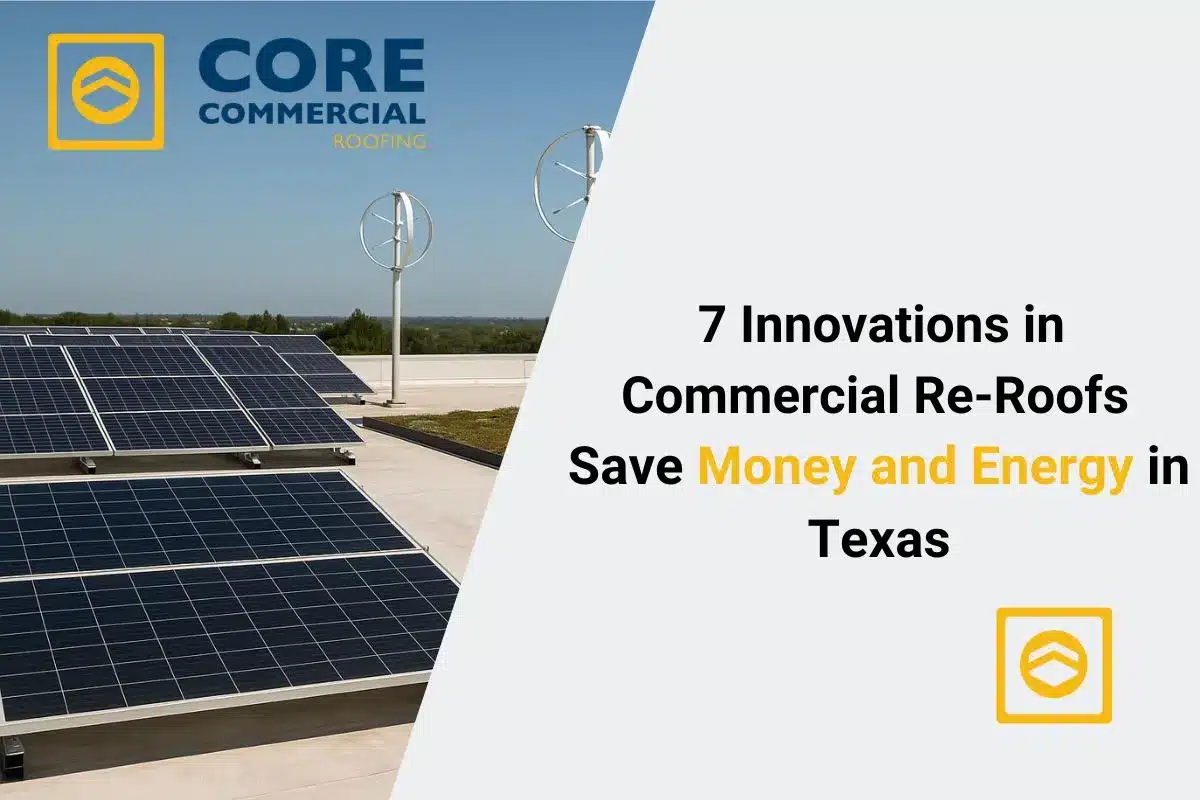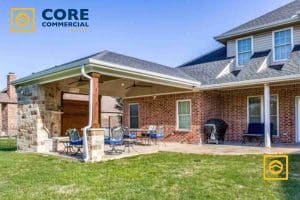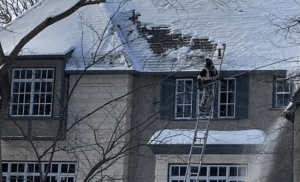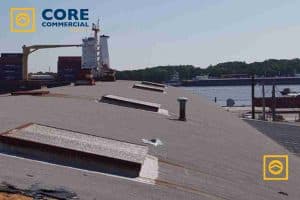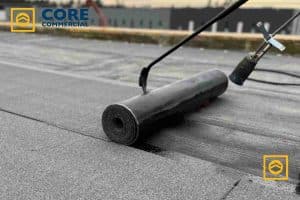Texas businesses spend more on cooling than almost anywhere else in the United States. High solar heat, hurricane-strength winds, and dramatic temperature swings challenge every flat-roofed warehouse, retail center, and office building from El Paso to Corpus Christi. The good news? A new wave of roof technologies dramatically lowers energy bills, extends roof life, and even turns the roof into a revenue producer. This guide explains seven breakthrough solutions tested in Texas heat that cut operating costs, boost comfort, and lighten your building’s carbon footprint.
Table of Contents
Why Innovative Commercial Re-Roofs Important in Texas
Innovative commercial re-roofs are important in Texas because they lower energy bills and help owners follow new laws. Since Texas has extreme heat and over 300 sunny days a year, old black roofs make air conditioners work too hard. New reflective roofs can cut cooling needs by 20% in cities like Dallas.
Also, the 2024 Texas energy code now requires commercial buildings to have better insulation. Upgrading to a modern roof helps businesses meet these stricter rules, saves money on electricity, and keeps tenants comfortable.
Cool Roof Coatings: Reflecting Heat, Saving Cash
Cool roof coatings are bright white or light-gray acrylic, silicone, or elastomeric layers rolled or sprayed onto existing membranes. They bounce sunlight instead of soaking it up.
High reflectance (≥0.80) and high emissivity (≥0.90) surfaces send solar radiation back into the sky. Roof temperatures can drop 50°F versus aged EPDM.
Benefits Texans Notice
| Benefit | Real-World Result |
|---|---|
| Lower HVAC loads | Up to 8 percent total building energy savings in Houston tests |
| Extend roof life | UV protection slows cracking and chalking |
| Quick install | Applied without major tear-off—ideal for active operations along State Highway 183 |
| Storm resilience | Seamless coating reduces wind-uplift failures common on the Gulf Coast |
Tips for Selection
- Choose coatings with CRRC (Cool Roof Rating Council) labels.
- In hail-prone Lubbock, add ceramic microspheres for impact resistance.
- Maintain with annual washes so dust from West Texas doesn’t dull reflectivity.
Solar-Ready Roofing Systems
Texas ranks second in the nation for solar potential, so preparing a roof for future energy generation is a smart financial move that avoids expensive retrofits later. To withstand Hurricane Alley storms, these systems feature double-mechanical attachment points rated for 140 mph winds, while embedded raceways keep wiring hidden and cool. They also utilize 60-mil TPO or reflective PVC, creating a bright surface that boosts the efficiency of modern bifacial solar panels.
Please check: types of commercial roofing systems
Payback Snapshot
A 100,000 ft² warehouse near Austin-Bergstrom International Airport spends about $0.09/kWh (ERCOT average). A 500 kW rooftop array offsets roughly $50,000/yr, paying back in 6–8 years when installed with a new roof.
Bonus: Federal & Texas Incentives
- Investment Tax Credit (ITC) 30 % through 2032.
- T-PPA utility buy-back plans offered by CPS Energy in San Antonio.
Insulated Metal Panels for Boosted R-Value
Insulated metal panels sandwich rigid foam (polyiso or PIR) between factory-finished steel skins. They combine the roof deck and insulation in one step.
Texas-Sized Advantages
- High Thermal Performance – R-7 per inch crushes code minimums; 4-inch panels hit R-28.
- Speedy Installation – Crews cover 50 % more area per day along Dallas North Tollway vs. built-up roofs.
- Fire & Wind Ratings – UL Class A and 150-mph uplift approvals.
Cost vs. Savings
Yes, IMPs cost 15–20 % more upfront than single-ply + polyiso combos. But facility managers in Fort Worth’s Alliance corridor report HVAC runtime cutbacks pay back the extra cost within 4 years.
Integrated Roof Daylighting
Prismatic skylights, solar light tubes, and daylight-redirecting domes capture North Texas sun and deliver glare-free light 30–40 feet into warehouse aisles.
Energy Math
Every 1 percent increase in daylight availability reduces lighting electricity by ~2.4 percent. In a Cedar Park distribution center averaging 20 ft-candles, daylighting saved $0.14/ft² annually.
Design Tips
- Use impact-rated lenses for hail zones north of US-82.
- Space skylights, one per 1,000 ft², for balanced light.
- Pair with occupancy sensors to dim LEDs when sunlight shines.
Smart Drainage and Rainwater Harvesting Roof Designs
Texas flash floods often overwhelm traditional scuppers, leading to membrane-damaging ponding. Smart drainage designs solve this by using tapered insulation to channel water efficiently into interior drains or “blue roof” detention systems. This approach reduces leak risks along Houston’s Beltway 8 and allows facilities to capture runoff for irrigation. In San Angelo, these systems have met up to 70% of non-potable water needs, cutting utility costs while securing LEED and Austin Green Building credits.
Roof-Mounted Micro
Texas’s Interstate 20 wind corridor offers ideal conditions for vertical-axis wind turbines (VAWTs), where average speeds consistently top 11 mph. Standing just 4–6 feet tall, these units spin quieter than standard HVAC equipment and integrate seamlessly with solar-ready electrical paths.
Adaptive Green Roof Zones for Urban Texas
Full green roofs are often heavy and costly, but adaptive zones offer a smarter alternative. By placing modular vegetated trays in high-heat areas, businesses minimize structural weight while maximizing impact. Unlike permanent slabs, these trays are removable for easy maintenance, delivering proven results like 6–9°F temperature drops in Downtown Houston and boosted ESG scores in Austin.
Real-Time Roof Monitoring Sensors and IoT
Real-time roof monitoring through IoT sensors transforms reactive maintenance into a proactive strategy by embedding wireless trackers to monitor moisture, membrane tension, and fastener stability. Instead of waiting for a leak to become visible, facility managers receive instant dashboard alerts, allowing them to catch punctures within hours rather than weeks – a shift that can save $8–$12 per square foot in damage mitigation costs. This data-driven approach also eliminates guesswork by optimizing coating re-applications based on actual UV exposure, a benefit proven at a logistics center off Baytown’s SH-330, where emergency repair calls dropped by 60 percent in the first year of installation.
Choosing the Right Innovation for Your Texas Facility
- Audit Your Roof’s Current Pain Points – Is heat load or storm damage the costliest line item?
- Match Innovation to Climate Zone – Gulf Coast roofs prioritize wind uplift and mold; Panhandle roofs target hail impact and freeze-thaw.
- Stack Incentives – Pair cool coatings with solar-ready prep to maximize tax credits.
- Plan Phased Upgrades – Not every roof needs all seven solutions on day one. Start where ROI is fastest (often coatings + daylighting).
- Measure Results – Verify savings with pre- and post-retrofit utility data. Sensors make this easy.
- Engage Experienced Texas Installers – They understand local codes, like Dallas Title 26 Chapter 52 wind-borne debris rules.
Key Takeaways
- Reflect, insulate, generate, and monitor – that four-part strategy can cut a Texas facility’s energy spend by up to 35 percent.
- Integrating innovations at re-roof time delivers the lowest lifetime cost.
- Each option pays off faster than ever thanks to federal tax credits, state incentives, and rising grid prices.
Your roof isn’t just a cover; it’s a hardworking asset. With the right mix of today’s commercial re-roof innovations, Texas businesses from Lubbock cotton gins to Houston medical labs can turn sizzling sun and stiff winds into bottom-line savings, while keeping tenants cool and proud.
FAQs
What are the latest innovations in commercial roofing?
The latest innovations include cool roofs that reflect sunlight and reduce heat absorption, green roofs with vegetation for insulation, and solar roofing integrated directly into the roof structure. Solar shingles and tiles now blend seamlessly with roofs while generating energy. Smart roofing systems with IoT technology provide real-time monitoring, detecting moisture, leaks, and weather conditions to optimize energy use. In Texas’s harsh climate, these technologies help commercial buildings stay cooler and save significantly on energy costs.
How much money can a commercial re-roof save on energy bills?
Cool roofs can lower energy costs by up to 15% by reflecting more sunlight and absorbing less heat. Metal roofs provide a 10-25% reduction in energy costs. In Texas where summer temperatures regularly exceed 100°F, these savings add up fast. Core Commercial Roofing & Coatings specializes in energy-efficient roofing solutions that help Texas businesses cut cooling costs year-round. For a 10,000 square foot commercial building spending $3,000 monthly on cooling, that’s $450-$750 in monthly savings during peak summer months.
What is the most energy-efficient commercial roofing system?
Cool roofing systems designed to reflect sunlight and reduce heat absorption are among the most energy-efficient, especially when combined with solar panels or green roof systems. TPO roofing excels in solar reflectivity with its white surface reflecting up to 80% of sunlight, significantly reducing interior cooling needs. Green roofs with vegetation act as insulation, reducing heat transfer and lowering demand for cooling in summer and heating in winter. For Texas commercial buildings, white TPO or PVC membranes with high solar reflectance work best in our intense heat.
How long does a commercial re-roof typically last?
Commercial roofing lifespans vary by material: asphalt shingles need more frequent replacement, while metal roofs last significantly longer. TPO systems are designed to last 20 to 30 years with consistent energy savings throughout their lifespan. Metal roofs can last between 40 to 70 years, while TPO roofs usually last 15 to 25 years depending on maintenance and environmental conditions. In Texas, proper installation and regular maintenance are crucial because extreme heat, hail, and storms can shorten roof life. Core Commercial Roofing & Coatings provides warranties and maintenance programs to maximize your roof’s lifespan in Texas conditions.
What is cool roof technology and how does it save energy?
Cool roofs offer substantially greater thermal resistance than conventional roofing materials, losing less heat during hotter months and requiring less air conditioning in summer. Thermal roof coatings and reflective materials help keep buildings cooler, reducing the need for air conditioning and making buildings more eco-friendly. Cool roof systems maintain a building’s ambient temperature by reflecting sunlight to retain less heat, using composite shingles or metal sheets with light-colored coating. For Texas warehouses, retail centers, and office buildings, cool roofs can drop roof surface temperatures by 50-60°F compared to traditional dark roofs.
Is it cheaper to repair or replace a commercial roof?
While asphalt shingles are budget-friendly ranging from $4.60 to $9.20 per square foot, they may need more frequent repair and have a shorter lifespan than other materials. If your roof is over 15-20 years old or has widespread damage, replacement is usually more cost-effective long-term. The average commercial flat roof replacement in Texas costs $524,434, ranging from $150,000 to over $1.5 million depending on size and materials. Minor repairs might cost $2,000-$10,000, but if you’re repairing the same issues every year, replacement saves money. Core Commercial Roofing & Coatings offers free roof inspections to help Texas businesses determine whether repair or replacement makes better financial sense.
What are the benefits of TPO roofing for commercial buildings?
TPO offers energy efficiency through reflective properties that reduce cooling costs, durability against weathering, flexibility to handle building movement, and cost-effectiveness compared to other commercial roofing options. TPO’s bright white surface reflects UV rays and heat, saving money during summer by decreasing energy usage to cool the interior. TPO is made without chlorine, resists chemical pollutants, and is 100% recyclable, helping reduce carbon emissions and supporting green building standards. TPO is the most cost-effective flat roofing material with a median price of about $5.20 per square foot. For Texas businesses, TPO handles extreme heat excellently and keeps energy bills low.
How do solar reflective roof coatings reduce cooling costs?
Cool roofing coatings reduce roof surface temperature, leading to decreased external heat impacting buildings without requiring a complete overhaul or replacement. Reflective coatings can reflect up to 80% of sunlight, keeping rooftop temperatures lower and reducing interior cooling needs. These coatings create a barrier between the sun’s rays and your building, preventing heat from radiating inside. In Texas summers where roof temperatures can reach 170°F, reflective coatings can drop that to 110-120°F, cutting AC runtime by 20-30%. They cost $1-$3 per square foot and typically pay for themselves in energy savings within 3-5 years.
What is the ROI on a commercial roof replacement?
Modern commercial roofing materials are designed to reflect sunlight and reduce heat transfer, lowering cooling costs and improving energy efficiency. Cool roofs can lower energy costs by up to 15%, a significant figure considering rising energy costs globally. With energy savings of $5,000-$15,000 annually for a typical Texas commercial building, plus reduced maintenance costs and longer lifespan, most energy-efficient roof replacements pay for themselves in 7-12 years. Add in increased property value, improved tenant comfort, and potential insurance discounts, and the ROI becomes even stronger. Many Texas businesses also qualify for energy efficiency rebates and tax incentives.
Can you install solar panels during a commercial re-roof?
Yes, and it’s the smartest time to do it! Solar roofing involves installing solar panels on the roof surface, and integrated solar solutions are gaining traction in commercial roofing. New solar shingles and tiles blend seamlessly with the rest of the roof, providing a sleek appearance while generating energy. Installing solar during re-roofing saves money because contractors can coordinate the work, properly reinforce mounting points, and ensure warranty coverage. Core Commercial Roofing & Coatings partners with solar installers to provide integrated solutions for Texas commercial buildings, maximizing both roof performance and energy generation. In Texas with abundant sunshine and high electricity costs, solar combined with a new energy-efficient roof delivers maximum savings.

